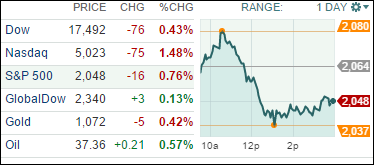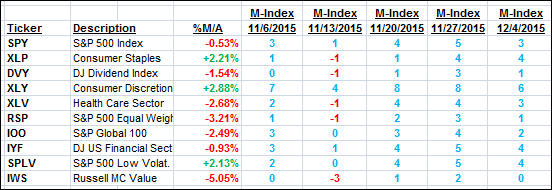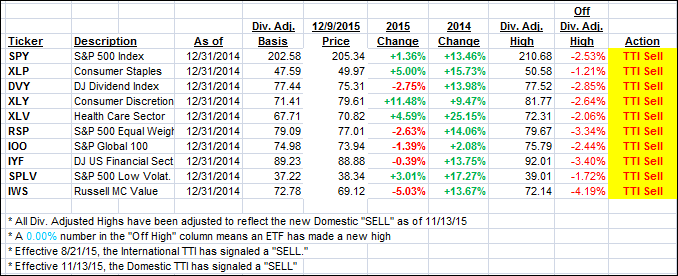
1. Moving the Markets
Hopes of halting a two-day slide were dashed today as an early stock rally, which now looks like a gigantic head fake, faded and the Dow finished near the bottom of a huge 300-point swing. The Dow was doing fine in the first half of the day, gaining as much as 200 points before sinking fast in the afternoon to as much as a 100-point decline. The S&P 500 vacillated within a range of 43 points, or over 2%. These types of moves tend to happen at major inflection points meaning the next breakout could produce a sharp move in either direction.
Oil prices remained volatile in Wednesday’s trading as financial markets have come under pressure this week on oversupply concerns after OPEC countries decided to maintain current production levels. Prices recouped some losses early though after the government reported that crude supplies fell for the first time in 11 weeks, dropping 3.6 million barrels last week. U.S Crude closed the day at $37.20 a barrel.
And in housing news, the prospect of higher interest rates may be nudging more Americans to refinance their mortgages. We heard from the Mortgage Bankers Association today that mortgage applications rose a seasonally adjusted 1.2% the week ending Dec. 4 and that the increase was driven by refinancing applications, which jumped 4% from the previous week. Although refinancings don’t directly bolster the housing market, they can help the economy by leaving more spending money in consumers’ pockets each month—at least that’s how the theory goes.
All of our 10 ETFs in the Spotlight succumbed to the sell-off and closed lower. Giving back the most were Consumer Discretionaries (XLY) with -1.28% while the Global 100 (IOO) held up best with a modest loss of -0.31%.
2. ETFs in the Spotlight
In case you missed the announcement and description of this section, you can read it here again.
It features 10 broadly diversified ETFs from my HighVolume list as posted every Monday. Furthermore, they are screened for the lowest MaxDD% number meaning they have been showing better resistance to temporary sell offs than all others over the past year.
Here are the 10 candidates:

The above table simply demonstrates the magnitude with which some of the ETFs are fluctuating in regards to their positions above or below their respective individual trend lines (%M/A). A break below, represented by a negative number, shows weakness, while a break above, represented by a positive percentage, shows strength.
For hundreds of ETF/Mutual fund choices, be sure to reference Thursday’s StatSheet.
Year to date, here’s how the above candidates have fared so far:

Again, the first table above shows the position of the various ETFs in relation to their respective long term trend lines (%M/A), while the second one tracks their trailing sell stops in the “Off High” column. The “Action” column will signal a “Sell” once the -7.5% point has been taken out in the “Off High” column.
3. Trend Tracking Indexes (TTIs)
Our Domestic Trend Tracking Index (TTI) dropped below its trend line and back into bear market territory confirming our cautious stance as uncertainty and volatility prevailed during the past 6 weeks.
Here’s how we closed:
Domestic TTI: -0.47% (last close +0.02%)—Sell signal effective 11/13/2015
International TTI: -4.64% (last close -4.37%)—Sell signal effective 8/21/2015
Disclosure: I am obliged to inform you that I, as well as advisory clients of mine, own some of these listed ETFs. Furthermore, they do not represent a specific investment recommendation for you, they merely show which ETFs from the universe I track are falling within the guidelines specified.
Contact Ulli